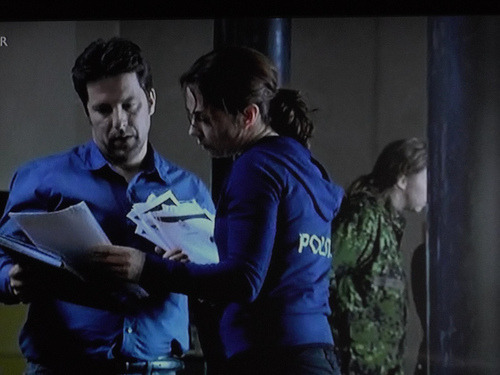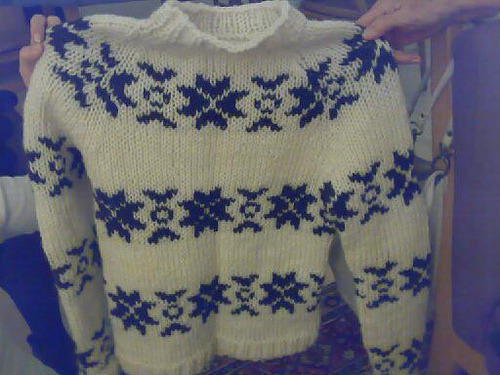As a society we are obsessed with murders, particularly of the gruesome kind. Detective stories are ten a penny, with the formula usually involving a pretty young girl who ends us the victim of some violent crime. There is always blood, severed limbs, a psychopath, and a detective who works out the case against the odds. British TV is full of it: with tired Sunday night repeats of Poirot, Midsomer Murders, and Miss Marple. The first time I watched the Danish series, ‘The Killing’, I felt the dying genre had been brought back to life, injected with some dynamism and street cred. It’s not just that jumper that makes it worth watching: the culmination of cutting edge techniques, brilliant acting and a winning script has made it so successful worldwide and a third series has been commissioned, with America even making its own version.

The first series of ‘The Killing’ follows the case of murder victim Nana Birk Larsen who is murdered on Sarah Lund’s last day of work. The story operates in proportional time, with 24 hours of action unfolding in one hour’s episode. As the twenty hours unfold, we see the consequences of Nana’s death on her family, on Lund and her team, and on the candidates who are running to become Mayor in the local election (Troels Hartman especially, who is accused as her murderer). The first series was still being written as it was filmed which made the production unnerving but edgy, which I think translates on screen.
Like most other detective novels and dramas, ‘The Killing’ draws on The Gothic genre to fuel the storyline, though it translates these conventions into modernity to make them relevant to society’s current fears. Instead of damsels in distress, locked in castles it focuses on modern fears: corruption amongst the political elite, locked chambers of the mind, inaccessible to ourselves and the experts and in the second series, the ultimate modern-day Gothic – that of terrorism threat. Nana’s shining knight appears not on horseback but in the form of DCI Sarah Lund whose instincts are usually right. The case of Nana really captures Sarah’s imagination, it is not clear whether it is because the victim was young and attractive, whether it’s because Sarah is a mother too (Sarah and Nana’s mother look very similar and both become obsessive) or perhaps, more accurately Sara does not really want to leave her job because she loves it so much.
Feminists would argue ‘The Killing’ portrays another of society’s modern day Gothic fears: that of a strong, successful woman. In Lund’s quest for the truth, she constantly comes up against male (and female) colleagues who think she is acting unreasonably or is getting too emotional, too attached to the case. She is criticized in her role as mother and as lover as she becomes more involved with the case. The precarious, well known balancing act becomes almost impossible as she tries to succeed in a largely male dominated world. She is deemed hysterical, at one point even getting sectioned by her superiors. The debate of whether woman can have it all has an ironic undertone in the plot.
Lund represents the struggling woman then, but also anybody who tries to fight the system, to pursue good and truth in a world where murderers, corrupt politicians and a dogged media thrive. Everybody can see a bit of themselves in Lund which is central to her success as a protagonist. She is not perfect but she believes she is doing the right thing and refuses to be beaten. Unlike Poirot and Marple, she is more complex, more human and therefore more real. She does not claim to have all the answers, she is not perfect and so she becomes more likable.

That patterned jumper has a use too. It is a very clever prop which symbolizes Lund’s human quality in a world that actually isn’t particularly nice. It arguably desexualizes Lund and at points she seems almost asexual which helps both a male and female audience relate to her. It adds another dimension too: when the jumper does get taken off – which does not occur very often – it is usually Lund at her most vulnerable. Unlike modern pop culture which saturated its audience in sex so we become desensitized to its effects, when she does finally take the jumper off and sits in just a vest, it is more revealing than if she had performed a strip-tease.
If conventions of Hollywood have become predictable and British drama is stifling then Denmark currently represents cool and after the success of the ‘Wallander’ series, our interest in all things Scandinavian has soared and I expect its tourist boards are currently reaping the rewards. The mise en scene portrays the beautiful city of Copenhagen with dark undertones of what’s actually going on there and elsewhere globally at the moment. The American remake, set in Seattle, stays true to the original with long, dark shots which create a real sense of emptiness in a big city. The series draws on its own cultural Gothic: the Danish psyche, unlike the Hollywood one, has hardly been explored and it brings something fresh, new and exciting to the screen. It rejuvenates the detective form and both series of the drama embody the sense of alienation from modernity perfectly. And the jumper isn’t bad either.
Pictures are the copyright property of their producers
